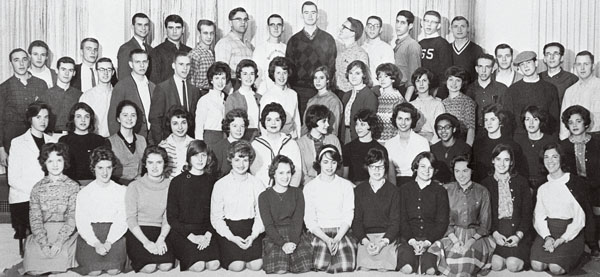Rochester Review :: September/October 2015

CLASS TRADITIONS: When members of the Class of 1965 returned for their sophomore year (above), they were expected to inculcate the incoming freshman class in the ways of campus life, such as the proper etiquette for wearing beanies, and other traditions. (Photo: University Libraries/Department of Rare Books, Special Collections, and Preservation)
For the first two years of her life as a Rochester undergraduate, Gwen (Meltzer) Greene ’65 joined other women students late in the afternoon to wait for dinner in the Women’s Residence Halls. At the appointed time, the women took their seats for meals that were served family style. After dinner, the time was their own, but the women—and only the women—had to be back in their dorm by 11 p.m. on weeknights and by 1 a.m. on weekends.
When Greene and her classmates returned to campus for their junior year in September 1963, the residential world of the River Campus was noticeably different. Greene moved into “the Towers,” a pair of high-rise residence halls that had opened that summer. Restricted to upperclassmen in the Classes of 1964 and 1965, the dormitories represented an experiment in campus living that was new in American college life—men and women were assigned to live on different floors in the same building.
Celebrate Meliora Weekend
In addition to reunion celebrations for classes ending in ’0’s and ’5’s, Meliora Weekend, October 8 to 11, features homecoming, parents weekend, and a program of presentations, talks, and activities for alumni, students, faculty, parents, and friends. Learn more at the website, rochester.edu/
melioraweekend.
Gone were the curfews and other parietal rules for the women in the Towers (although they remained in effect for the Women’s Residence Halls), gone were many of the dinner rituals (the Towers complex would include a new cafeteria-style dining hall), and disappearing quickly was the notion that young people—and young women in particular—could not be empowered to take a greater role in supervising themselves.
“Moving into the Towers, that was the defining thing for our class,” Greene says as she prepares for her 50th reunion this fall.
Now a member of the University’s Board of Trustees, Greene says it’s hard to describe the excitement that many students felt about being part of such a moment. “It was defining for the whole country. It helped changed the whole residence hall structure of college.”
Such memories are on the minds of many members of the Class of 1965 as they look forward to returning to campus for reunion and other activities during Meliora Weekend, October 8 to 11. As part of a 50th reunion tradition, the reunion’s organizing committee asked each member of the class to contribute brief summaries of their lives since graduation as well as short accounts of their fondest campus memories.
According to some of those memories, the transition to coed living made a deep impression, but for most, being on the River Campus from the fall of 1961 to the spring of 1965 was excitement enough: it was a time of making strong friendships, of immersion in oftenrigorous academic opportunities, and of enjoying the camaraderie of being among a group of smart and energetic young people.
There are memories of panty raids and beer blasts, fraternity parties and Dandelion Day; there was Frosh Camp and Flag Rush. The freshmen wore beanies and proudly put to memory a handful of Rochester spirit songs.
But seeping into that narrative are inklings of political, social, and cultural change in the world around them.
Some note the deepening cold war, prompted by the Bay of Pigs invasion and the Cuban Missile Crisis. They remember the pall cast over campus when John F. Kennedy was assassinated.
As the class members returned for senior year, they had witnessed Freedom Summer, as well as violent race riots in Rochester, Los Angeles, and elsewhere. And by the spring of 1965 some faculty and students were organizing “teach-ins” and taking part in national marches against the escalating war in Vietnam.
Campus life mirrored some of those tensions as well.
Some who were in NROTC write that they forged close friendships and found support for their studies—but also recall increasing antiwar sentiment making their experience at Rochester “caustic” and “unpleasant.”

CAMPUS KEEPSAKES: Sharon Cornell Rose ’65 has kept her freshman beanie as well as a stuffed “U of R” dachshund, and other mementos of campus life. (Photo: Adam Fenster)
The class also includes Bonnie Thornton Dill, one of the first African-American women to live in a Rochester dorm. When Dill was admitted, the administration sent letters to some of her women classmates, asking if they would be comfortable rooming with an African American. Dill, now the dean of the College of Arts and Sciences at the University of Maryland, notes that she made good friends at Rochester and received a good education, but that being the only African-American woman “was not something I’d recommend to my children or grandchildren nor is it something I would do again.”
“I think what all of it meant was that there was change in the air, and people were just beginning to cope with it,” says Barbara Baer ’65, who transferred to Rochester as a junior and moved into the Towers, where she was elected to the first council that represented students there.
“Something was going on that was much deeper than just the day-to-day of going to class,” says Baer, who majored in political science before embarking on a career as a political strategist in New York City. “It was really the beginning of the real revolution in the way we think, act, and behave.”
By the early 1960s, colleges across the country were beginning to recognize some of those changing dynamics. Indiana University is believed to have opened the first coeducational dorm in 1956, according to the Chicago Tribune, but at a time when many elite universities had not yet become coeducational, the concept of men and women living in a single building was slow to catch on.
At Rochester, administrators credited students with being “intelligent young people, capable of mature judgment” who could handle the new arrangement but were careful to assure alumni and parents that the University was moving cautiously.
“It is only the confidence and pride in the judgment of Rochester men and women that has permitted us to embark on this program,” wrote Joseph Cole, dean of student affairs, in the September-October 1963 issue of Rochester Review.
“We recognize the Towers as experimental and we expect it will be necessary to evaluate the program on the basis of experience. Not all of the upperclass students can be accommodated in the Towers; this insures the opportunity of choice for those students (and parents) who feel that the Towers do not provide a living unit appropriate for the needs of a given student.”

COULD THEY SHARE A DORM? Towers residence halls was one of the first coed dorms in the country. The buildings are designed so that groups of four to six students live together in suites. Each floor is designated for men or for women. Residence is limited to upperclassmen, and women living there no longer have to follow the parietal rules enforced in the Women's Residence Halls (now Susan B. Anthony Hall).
Today, the Towers are Anderson and Wilder Halls, the original complex’s dining center is now the Sage Art Center, and a newly opened dorm, O’Brien Hall, completes what is known as Jackson Court. The Women’s Residence Halls is the coed Susan B. Anthony Hall. And the idea of being assigned to live in a building based on sex or of having a curfew would be as puzzling to students as the idea that students once had to wait in a common area to use a single phone.
Former Yellowjacket quarterback and Hall of Fame inductee David Wormuth ’65 has watched campus change over several decades, first as a member of the Class of 1965 who relinquished a scholarship to play football at Syracuse in order to transfer to Rochester, and later as associate director of admissions. Rochester always had high expectations for its students, he says. “Rochester was quite unique in being small, selective, and coed,” he says. Although thought to be slow to change, the University had a willingness to experiment, as the transition to the Towers can attest. “I marvel at that. I thought Rochester was a fairly conservative school at the time.”
Of the more than 600 or so in the class, 32 married another Rochester graduate. At least 26 children of the class eventually enrolled at Rochester.
Dick Rice ’65 says that regardless of the impending social and political changes facing students, there was an excitement about being at Rochester during the early 1960s.
“When you walked across campus, you looked someone in the eye because you knew they were your friend,” says Rice, who in a career as a consulting engineer worked on many of the buildings that have sprung up on campus since 1965. “It reminds me of why the U of R is special.”
In many ways, the practicalities of the era—no cellphones, no laptops, few cars—helped bring classmates together, he says. “We recognized the importance of education, and we didn’t have the distractions that pull people away.”
Some of the class statistics attest to a focus on academics—the class included Rhodes Scholar–winning physics student Tim Londergan—as well as time for social engagement, personal friendships, and a commitment to their alma mater.
Several have had prominent careers in academia, business, and other fields. Of the more than 600 or so in the class, 32 married another Rochester graduate. At least 26 children of the class eventually enrolled at Rochester.
In addition to Greene, two others—Tom Sloan and Sheila Blumstein—have served as current or former trustees.
Members of the class raised families—and are proud parents and grandparents—served in the military, and volunteered in social, cultural, and community organizations.
A French major, Greene moved to New York City after graduation and eventually became a financial advisor for JP Morgan Securities. On campus, she tried to take advantage of as many opportunities as she could, volunteering to write the constitution for the Towers, helping teach inner-city school children, and serving as an usher at W. Allen Wallis’s inauguration as University president.
The society of the early 1960s put less pressure on students, she says, giving them more time and space to explore. Since graduation, she has mentored students interested in working on Wall Street and has counseled students who were recipients of scholarships that she has established. She has noticed that current students seem to be much more aware of how to move ahead in their careers.

“For me, college was a time to learn who I was and get a greater sense of self-confidence, and know that I was with a lot of smart people,” she says. “It never would have occurred to me that I was building a résumé.”
Baer says the sense of developing maturity and growing independence are important aspects of college life, then as now. Learning to navigate the social and administrative nuances of a coed dormitory was part of that, but so was finding the time to discover what you wanted out of life.
“The U of R really changed my life,” she says. “It’s important to do well academically, and to find your passion. But the people you meet, if you’re lucky, can really shape part of what the rest of your life will be. That kind of opportunity to exchange ideas, to talk, to think, it doesn’t come often in the rest of your life. College is the one time when you can really start to understand what the world is like. I think the U of R did that for me.”
